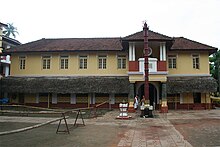
Siddharudha Swami is an Indian Hindu guru and philosopher.

Kashi Math is a matha (monastery) and a spiritual organisation followed by the Madhva section of Gaud Saraswat Brahmins, who are also referred as Madhwa Saraswat Brahmins or Vaishnava Saraswat Brahmins. It dates back to the 16th century. With its headquarters in Brahma Ghat, Varanasi. Kashi Math has followers all over the Konkan belt, prominently in Mumbai, Goa, Udupi, Mangalore, Kochi and other parts of Karnataka and Kerala.

Shri Gokarna Math or Partagali Math is the first Gaud Saraswat Mathas of the Dvaita order, a system established by Jagadguru Madhvacharya in the 13th century AD. This matha also called Partagali Jivottama and is headquartered in Partagali, a small town in South Goa, on the banks of the river Kushavati.
The Chitrapur Guru Parampara or Guru Heritage of the Chitrāpur Sāraswat Brahmins is the lineage of spiritual teachers (gurus), also known as Mathadhipatis who have led the community throughout its history.
Swami Parijnanashram I, or Adi Parijnanashram, was the first guru and Mathadhipati, or head of a matha, of the Chitrapur Saraswat Brahmins. He is said to have been ordained by Lord Bhavanishankar in 1708 to guide the Chitrapur Saraswat community.
Swami Shankarashram I was the second guru and Mathādhipati of the Chitrāpur Sāraswats. He was ordained as the Mathādhipati in 1720 and served as the head till his death in 1757. He was the shishya (disciple) of Swami Parijñānāshram I.
Swami Parijnanashram II was the third Guru and Mathādhipati of the Chitrāpur Sāraswats whose reign was between 1757 and 1770. He was ordained as the guru by the elders of the community after Swami Shankarāshram I died without selecting a shishya (disciple). Normally it is the shishya who ordained by the guru, who succeeds as the guru of the community.
Swami Shankarāshram II was the fourth head guru or Mathādhipati of the Chitrapur Saraswat Brahmin community. He reigned from 1770 to 1785.
Swami Keshavashram was the fifth guru of the Chitrapur Saraswat Brahmin community, that is, the Fifth Mathādhipati (head of the Chitrāpur Matha) of the community. His reign was from 1785 to 1823, a period of 38 years. He became the head of the community after his teacher (guru) Swami Shankarāshram died in 1785.
Swami Vāmanāshram, also called Swamiji, was the sixth guru of the Chitrapur Saraswat Brahmin community(6th in the Guru Parampara). He reigned for 16 years from 1823 to 1839.
Swami Krishnashram was the seventh mathadhipati of the Chitrapur Saraswat Brahmin community from 1839 to 1863.

Swami Pāndurangāshram( Devanagari: पाण्डुरङगाश्रम्, Pan.du.ran.gā.śram) was the eighth guru of the Chitrapur Saraswat Brahmin community(Head of the community) for 52 years, from 1863 to 1915. He had succeeded his teacher Swami Krishnāshram after the latter attained Mahā-Samādhi(died) in 1857.
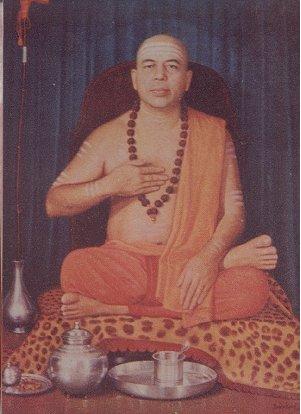
Swami Ānandāshram was the ninth guru and the Head of the community of the Chitrapur Saraswats. He succeeded his guru Swami Pandurangashram in 1915. He remained the Head of the community for a period of 51 years until he died in 1966.
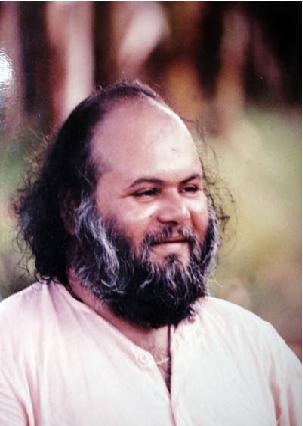
Swami Parijnanashram III was the tenth guru of the Chitrapur Saraswat Brahmin community. He succeeded his teacher Swami Ānandāshram in 1966 after the latter died.

Shri Gaudapadacharya Math, also known as Kavaḷē maṭha, located in Kavale, Ponda, Goa, is the oldest matha of the Smarthan Saraswat Brahman Samaj. It was founded by Gauḍapāda around 740 AD, whose student was Govinda Bhagavatpada, the guru of Adi Shankara, a highly influential figure in Hinduism. There is also a belief that Gauḍapāda himself established the Shri Gaudapadacharya matha when he lived in Gomantak (Goa). Thus, the matha came to be known as Shri Saunstan Gaudapadacharya matha. Unlike other mathas, Shri Gaudapadacharya matha is not a polemical center established to influence the faith of all Hindus, its jurisdiction is limited to only Dakshinatya Saraswat Brahmins. The Peetadhipathi "head monk" is Śrī Gauḍapadācārya. Smartist Goud Saraswat Brahman Samaj and Rajapur Saraswat Brahmin are its main disciples.

Swami Nigamananda Paramahansa was an Indian yogi, guru and mystic well known in Eastern India. He is associated with the Shakta tradition and viewed as a perfect spiritual master of vedanta, tantra, yoga and prema or bhakti. His followers idealized him as their worshipped and beloved thakura.
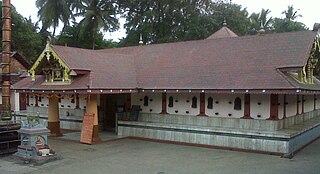
The Sri Lakshmi Narasimha Temple is the foremost temple of Gowda Saraswatha Brahmins in and around Thalassery.
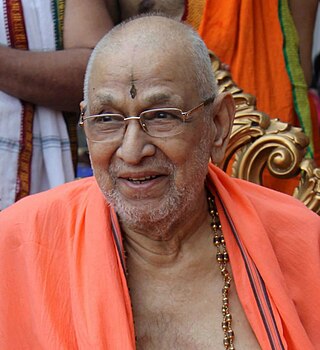
Shrimat Sudhindra Thirta Swami, also referred to as Shri Sudhindra Thirtha Swamiji, was the legal and spiritual head (mathadipathi) of the Kashi Math and the twentieth successive person called the swamiji of guru parampara.
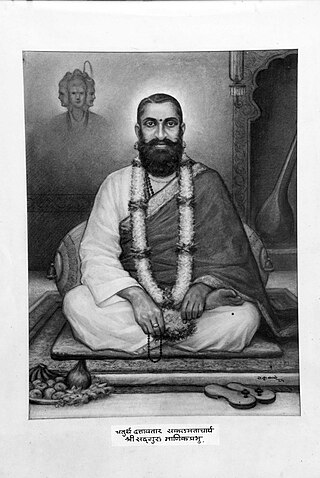
Manik Prabhu Maharaj was an Indian Hindu saint, philosopher, poet and guru. He is also regarded as an incarnation of Dattatreya by the people of Datta Sampraday. Prabhu's philosophy, the Sakala mata Siddhanta rests on the principles of Advaita Vedanta as propagated by Adi Sankara. Shri Prabhu strongly advocated the essential oneness of all religions. Prabhu's Muslim devotees revered him as an incarnation of Mehboob Subhani whereas his Lingayat devotees saw him as a form of Basavanna. Shri Prabhu composed numerous bhajans and padas in various languages such as Marathi, Kannada, Hindi, Urdu and Sanskrit. Shri Prabhu was also associated with the First War of Indian Independence in 1857. Shri Sai Baba of Shirdi, Shri Swami Samarth of Akkalkot, Shri Bramhachaitanya of Gondavale and many other contemporary saints are believed to have visited Maniknagar to interact with Prabhu on matters of deep spiritual wisdom. Biographers refer to Shri Prabhu as a saint of great spirituality and mysticism. Shri Prabhu's teachings emphasize the path of Bhakti. He also moralized on the vedantic truths concerning the spiritual unity of beings. Manik Nagar, Humnabad, Bidar District is the place where he took sanjeevani samadhi. Shri Prabhu's samadhi at Maniknagar is the nucleus of Manik Nagar and acts as the spiritual center of the activities of Shri Manik Prabhu Samsthan.
Sukrathindra Thirta, also referred to as Shri Sukrathindra Thirtha Swamiji, was the legal and spiritual head (mathadipathi) of the Kashi Math and the nineteenth successive person called the swamiji of guru parampara.
All these books are internal publication and are available with the Chitrapur Math
